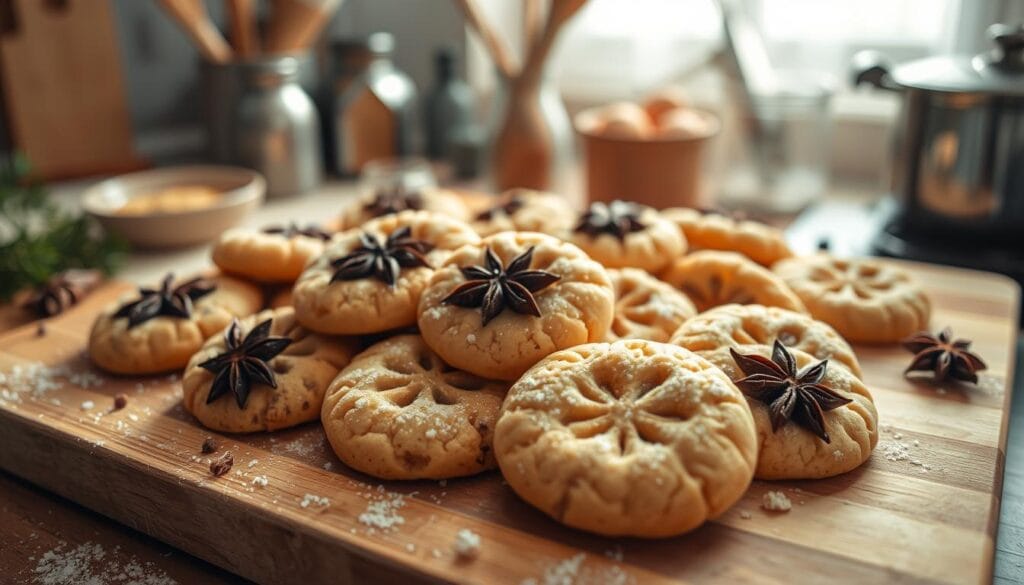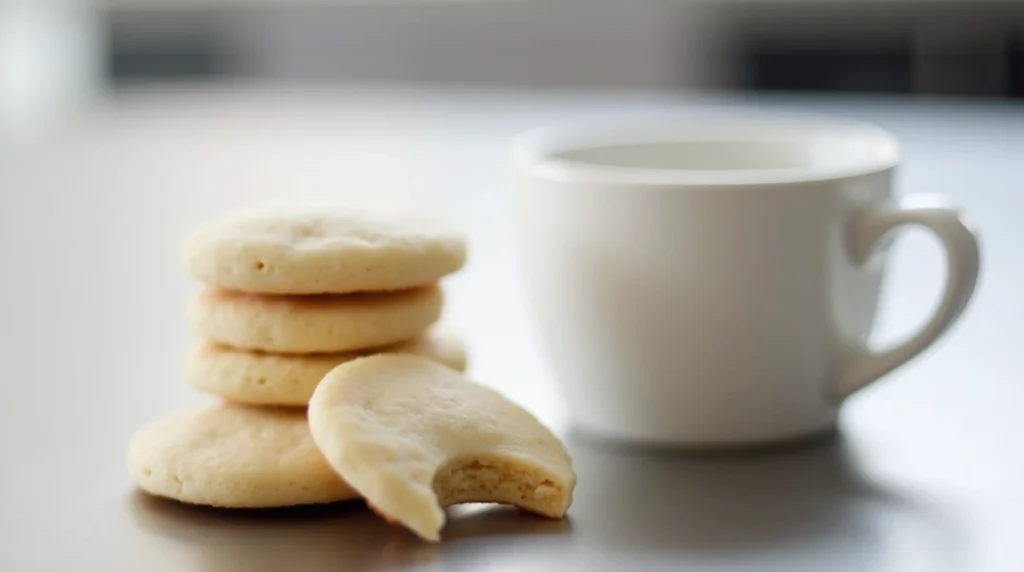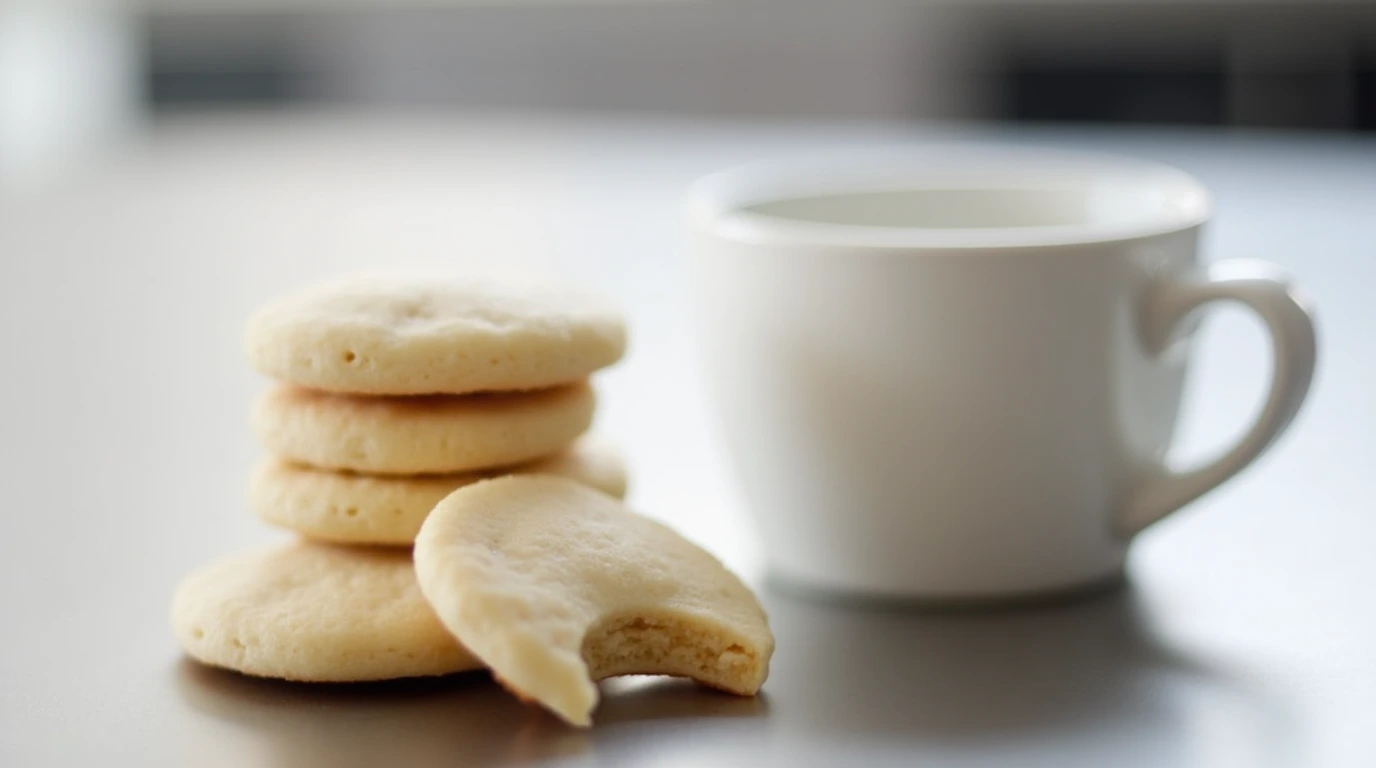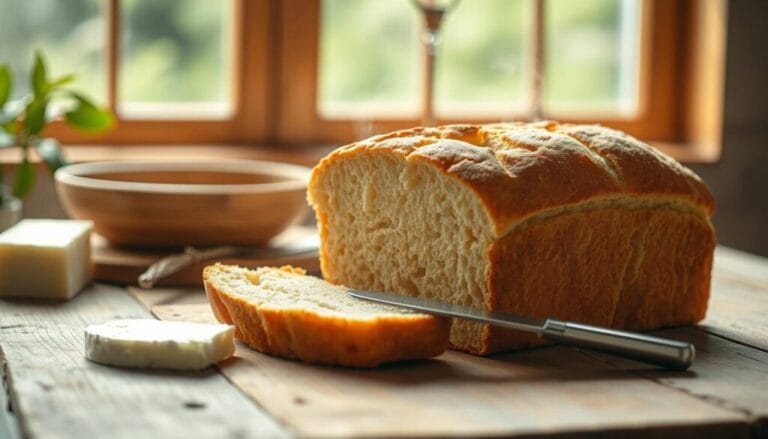Anise cookie recipe Quick and aromatic cookie idea
Did you know anise cookies are a traditional Italian treat? They’re made with simple ingredients and topped with a tasty frosting. You can make 24 delicious anise cookies with just 120 kcal each. You’ll need flour, sugar, butter, eggs, and anise extract for this recipe.
With this anise cookie recipe, you can whip up a quick and aromatic treat. You’ll need about 642 g of ingredients and bake at 325°F. You can keep the cookies at room temperature for a month or freeze them for three months.
Table of Contents
Key Takeaways
- You can make 24 anise cookies using a simple anise cookies recipe.
- Each cookie contains 120 kcal and is made with ingredients like all-purpose flour, sugar, and anise extract.
- The baking temperature for anise cookies is 325°F, and the cookies can be stored at room temperature for up to 1 month.
- Anise extract is a key ingredient in anise cookies, and the recommended amount is 2 teaspoons.
- You can customize your anise cookie recipe by using alternative ingredients like whole wheat flour or honey.
- Anise cookies are perfect for any occasion and can be served with a variety of side dishes like Caprese Salad or Prosciutto-Wrapped Melon.
Understanding Anise Cookies: A Traditional Treat
Anise cookies have a long history and are loved in many places. They get their special taste and smell from anise extract. Enjoy them as a sweet treat or dessert.
To make these cookies, you need flour, sugar, and anise extract. It takes about 10 minutes to prepare and 10 to 12 minutes to bake. This makes a batch of 20 to 22 cookies in 25 minutes.
Here are some key facts about anise cookies:
- Prep time: 10 minutes
- Cook time: 10-12 minutes
- Yield: 20-22 cookies
- Calories per cookie: 125 kcal
Anise cookies are special because of their unique flavor and aroma, thanks to anise extract. There are many regional versions, each with its own twist. You can try different ingredients and flavors to make your own recipe.
Essential Equipment for Your Anise Cookies
To make an easy anise cookie recipe, you’ll need some basic tools. You’ll need a baking sheet, a mixing bowl, and a whisk. Also, a measuring cup, a spoon, and a rubber spatula are necessary. Don’t forget a digital scale to measure ingredients accurately.
Here is a list of the essential equipment you will need:
- Baking sheet
- Mixing bowl
- Whisk
- Measuring cup
- Spoon
- Rubber spatula
- Digital scale
With the right tools, you can make delicious anise cookies. These cookies are easy to make and fun to eat. Having the right tools helps you follow the recipe accurately. This ensures your cookies are perfect every time.
The Perfect Anise Cookie Recipe
To make delicious anise cookies, you need the right ingredients and a tested recipe. This recipe has a 5-star rating from 8 reviews. It has been perfected after 18 testing iterations. You’ll get a batch of 13 cookies that everyone will love.
High-quality ingredients are key to a great anise cookies recipe. You’ll need fresh eggs, real anise extract, and pure vanilla extract. Also, all-purpose flour, almond flour, granulated sugar, and light olive oil are needed. The anise extract gives a distinct flavor, while vanilla adds sweetness.
- 1-½ cups (180 grams) all-purpose flour
- ¾ cup (75 grams) almond flour
- 1-½ teaspoons baking powder
- ¾ cup (150 grams) granulated sugar
- ⅓ cup (70 grams) light olive oil
- 1-½ teaspoons anise extract
- ½ teaspoon vanilla extract
With these ingredients and a few simple tips, you can make a delicious anise cookies recipe. Follow the recipe carefully and use high-quality ingredients. This will ensure the best flavor and texture.

Preparing Your Cookie Dough
To make the cookie dough, start by creaming butter and sugar together. Then, add eggs and anise extract. Make sure to sift the flour and baking powder well. Use a stand or hand mixer to mix until it’s smooth and creamy.
Here are the steps to prepare the cookie dough:
- Cream together ½ cup of unsalted butter and ½ cup of granulated sugar.
- Add 3 large eggs, preferably at room temperature, and 2 teaspoons of anise extract.
- Sift 2-¼ cups of all-purpose flour and 4 teaspoons of baking powder, then add to the mixture.
- Mix the dough until it’s smooth and creamy, then wrap it in plastic wrap and refrigerate for at least 30 minutes.
By following these steps, you’ll make a tasty anise cookie recipe. It makes 18 cookies, each with about 145 calories. Bake them at 350°F for 9-11 minutes, until they’re lightly golden.
Mastering the Anise Flavoring Process
To make tasty homemade anise cookies, you need to know how to flavor them with anise. Anise flavoring is key to these cookies. You can use anise extract, oil, or ground anise for a unique taste and smell.
Choosing the right type and amount of anise flavoring is important. Here are some tips:
- Start with a small amount of anise flavoring and adjust to taste, as anise can be quite potent.
- Use high-quality anise extract or oil for the best flavor.
- Consider combining anise with other flavors, such as lemon or almond, for a unique twist.
Mastering anise flavoring lets you make homemade anise cookies that everyone will love. With a bit of practice and patience, you can get the flavors just right. Your homemade anise cookies will become a favorite treat.
Baking Techniques for Perfect Results
To get perfect anise cookies, follow key baking techniques. First, preheat your oven to 350°F (180°C). Use a baking sheet lined with parchment paper or a silicone mat to prevent sticking.
For baking anise cookies, pay attention to time and temperature. Bake for 10-12 minutes, until the tops are cracked and lightly browned. Make sure to leave about 2 inches of space between each cookie.
Here are some tips for perfect anise cookies:
- Use the right ingredient ratios for the best flavors and textures.
- Avoid overmixing the dough to prevent tough cookies.
- Keep a consistent baking temperature for even baking.

By using these techniques and tips, you can make delicious anise cookies. Always use the right ingredients and follow the recipe carefully for the best results.
| Ingredient | Quantity |
|---|---|
| All-purpose flour | 2½ cups (325 grams) |
| Baking powder | 2½ teaspoons |
| Salt | ¼ teaspoon |
| Eggs | 2 large |
| Granulated white sugar | ⅔ cup (130 grams) |
| Extra virgin olive oil | ½ cup (120 mls) |
| Whole milk | ¼ cup (60 mls) |
| Anise extract | 1½ teaspoons |
| Vanilla extract | 1 teaspoon |
Decorating Your Anise Cookies
After baking your anise cookies, it’s time to decorate them. Decorating is a fun way to add a personal touch. You can make your cookies look amazing.
Start with traditional garnishes like chopped nuts or dried fruit. They add flavor and texture. Or, try modern ideas like powdered sugar, sprinkles, or frosting for a cool look.
Here are some decorating ideas for your anise cookies:
- Powdered sugar: Dust your cookies with powdered sugar for a simple yet elegant look.
- Sprinkles: Add sprinkles to your cookies for a fun and colorful touch.
- Frosting: Use frosting to create fancy designs or patterns on your cookies.
Be creative and have fun decorating. Try different toppings and decorations for a unique look. Your anise cookies will be a hit!
| Decorating Idea | Description |
|---|---|
| Powdered Sugar | A simple yet elegant look |
| Sprinkles | A fun and colorful touch |
| Frosting | Create fancy designs or patterns |
Follow these decorating ideas and use your favorite anise cookies recipe. You’ll make beautiful and tasty cookies that will wow everyone.
Storage and Shelf Life
After baking your anise cookies, it’s key to store them right. This keeps them fresh and flavorful. Store them in an airtight container at room temperature for up to 5 days. This method prevents them from getting stale or soggy.
To keep your cookies fresh longer, freeze them for up to 2 months. When you’re ready, thaw them at room temperature. Always use parchment paper or wax paper to protect the cookies from damage and loss of flavor.
Storage Methods
- Store anise cookies in an airtight container at room temperature for up to 5 days
- Freeze anise cookies for up to 2 months and thaw at room temperature when ready to eat
- Use parchment paper or wax paper to prevent cookies from becoming stale or soggy

By following these tips, you can enjoy your homemade anise cookies for longer. Always check the cookies for spoilage before eating. With the right storage, your anise cookies will stay fresh and delicious, perfect for snacking or sharing.
Troubleshooting Common Issues
When making homemade anise cookies, you might run into some common problems. These can mess with the texture, taste, and look of your cookies. It’s key to spot and fix these issues quickly.
Some common issues include overmixing the dough, baking the cookies too long, and using poor-quality ingredients. Overmixing can make your cookies tough and dense. Baking them too long can dry them out and make them crumbly. Using bad ingredients, like old baking powder or low-grade anise extract, can also ruin the taste and texture.
To avoid these problems, stick to the recipe and use top-notch ingredients. Don’t overmix the dough and watch the cookies closely while they bake. These steps can help you fix common issues and make tasty homemade anise cookies that everyone will love.
Here are some tips to help you troubleshoot common issues with homemade anise cookies:
- Use fresh and high-quality ingredients, including real anise extract and pasteurized eggs.
- Avoid overmixing the dough, as this can lead to tough and dense cookies.
- Keep an eye on the cookies while they’re baking, and remove them from the oven when they’re lightly golden brown.
Conclusion: Enjoying Your Homemade Anise Cookies
Making your own easy anise cookie recipe is a fun and rewarding experience. You can enjoy these traditional treats at home with just a few simple ingredients. The aroma and flavors will fill your home with warmth.
These anise cookies are perfect for any occasion, whether it’s a festive gathering or a moment of self-care. Each bite is a delight, blending licorice-like anise with buttery goodness. It’s like stepping into a cozy, comforting place.
As you get better at baking anise cookies, remember to have fun. Try new garnishes and flavor combinations. Share your creations with others. The joy of homemade cookies is in the making, not just the eating.
So, get ready to bake! Preheat your oven and gather your ingredients. Let the magic of anise cookies happen in your kitchen. Enjoy every moment and the sweet rewards of your masterpiece.
FAQ
What is the history and cultural significance of anise cookie recipe?
Anise cookies have a rich history, loved in many countries, like Italy. Their exact origins are unclear, but they’re thought to come from Italy. They’re special because of their unique flavor and aroma, thanks to anise extract.
What are the essential ingredients and equipment needed to make anise cookie recipe?
To make anise cookies recipe, you need basic equipment like a baking sheet and mixing bowl. You’ll also need a whisk, measuring cup, spoon, and rubber spatula. A digital scale is key for accurate measurements. The ingredients include flour, sugar, eggs, and anise extract, along with salt and baking powder.
How do I prepare the anise cookie recipe dough?
To make the dough, cream butter and sugar together, then add eggs and anise extract. Sift flour and baking powder for a smooth mix. Use a mixer to blend until creamy. Wrap the dough in plastic wrap and chill for 30 minutes to meld flavors.
What types of anise flavoring can I use in my cookies?
Anise flavoring is essential for anise cookies. You can use anise extract, oil, or ground anise. It’s important to measure correctly for the right flavor balance.
How do I properly store and preserve my anise cookie recipe?
Anise cookies can be stored in an airtight container at room temperature for up to 5 days. Freeze them for up to 2 months and thaw at room temperature. Use parchment or wax paper to keep them fresh.
What are some common issues with anise cookies and how can I troubleshoot them?
Common issues include overmixing, overbaking, and using low-quality ingredients. Follow the recipe carefully and use fresh ingredients. Avoid overmixing to prevent tough cookies.






